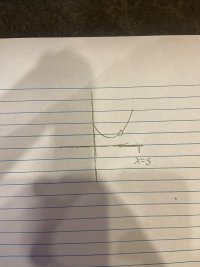Integrate
Junior Member
- Joined
- May 17, 2018
- Messages
- 129
Draw the graph of a function on [0, 5] with the given properties:
f (x) is not continuous at x = 1, but [math]\lim_{x \to 1^+} f(x)[/math] f (x) and [math]\lim_{x \to 1^-} f(x)[/math] exist and are equal.
---
From what I understand the definition of a limit existing is as follows
[math]\lim_{x \to a^-} f(x) = f(a) = \lim_{x \to a^+} f(x)[/math]
meaning that the both sides of the limit must approach f(a) but do not necessarily need to equate to each other.
Allowing us to never define what happens at f(a).
In other words I can just leave f(a) blank if I so desire.
I have made a very crude sketch.

Does this fit the given requirements?
I ask this question because the textbook solution does in fact give f(a) a value.
f (x) is not continuous at x = 1, but [math]\lim_{x \to 1^+} f(x)[/math] f (x) and [math]\lim_{x \to 1^-} f(x)[/math] exist and are equal.
---
From what I understand the definition of a limit existing is as follows
[math]\lim_{x \to a^-} f(x) = f(a) = \lim_{x \to a^+} f(x)[/math]
meaning that the both sides of the limit must approach f(a) but do not necessarily need to equate to each other.
Allowing us to never define what happens at f(a).
In other words I can just leave f(a) blank if I so desire.
I have made a very crude sketch.

Does this fit the given requirements?
I ask this question because the textbook solution does in fact give f(a) a value.

